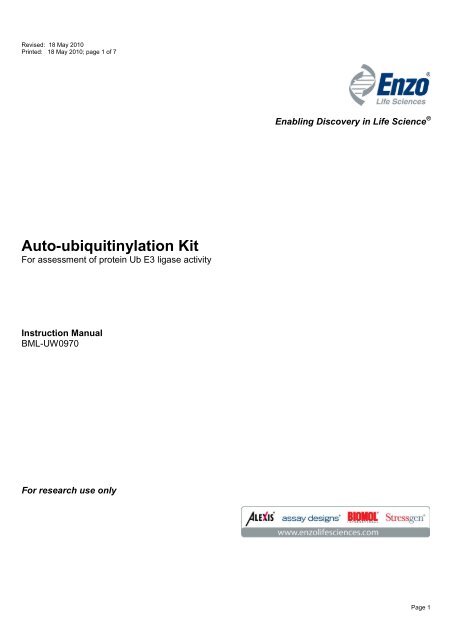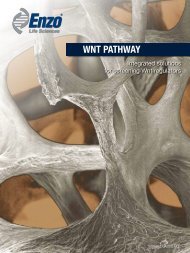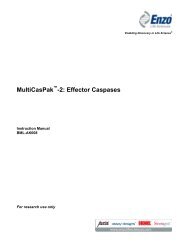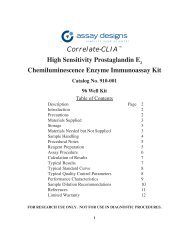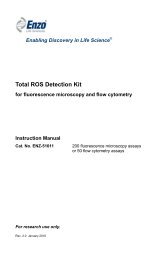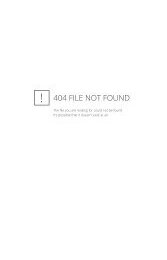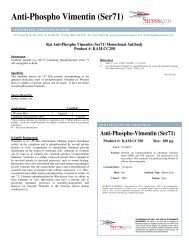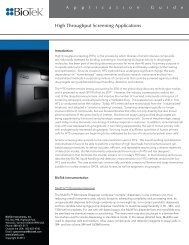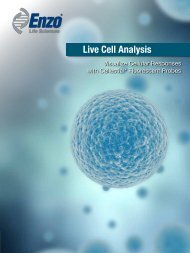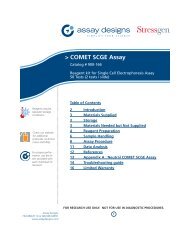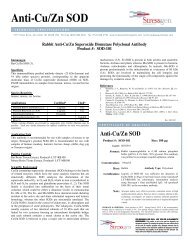Auto-ubiquitinylation Kit - Enzo Life Sciences
Auto-ubiquitinylation Kit - Enzo Life Sciences
Auto-ubiquitinylation Kit - Enzo Life Sciences
You also want an ePaper? Increase the reach of your titles
YUMPU automatically turns print PDFs into web optimized ePapers that Google loves.
Revised: 18 May 2010Printed: 18 May 2010; page 1 of 7Enabling Discovery in <strong>Life</strong> Science ®<strong>Auto</strong>-<strong>ubiquitinylation</strong> <strong>Kit</strong>For assessment of protein Ub E3 ligase activityInstruction ManualBML-UW0970For research use onlyPage 1
Revised: 18 May 2010Printed: 18 May 2010; page 2 of 7Product name(s):<strong>Auto</strong>-<strong>ubiquitinylation</strong> <strong>Kit</strong> For assessment of protein Ub E3 ligase activityPLEASE READ ENTIRE BOOKLET BEFORE PROCEEDING WITH THE ASSAY. CAREFULLY NOTE THE HANDLING AND STORAGECONDITIONS OF EACH KIT COMPONENT. PLEASE CONTACT ENZO LIFE SCIENCES’ TECHNICAL SUPPORT TEAM FOR ASSISTANCE IFNECESSARY.Catalogue number: BML-UW0970 Batch number: Expiry date: 6 months from receipt1. BackgroundThe covalent attachment of ubiquitin to proteins (<strong>ubiquitinylation</strong>) plays a fundamental role in the regulation of cellular function through biologicalevents involving cell cycle, differentiation, immune responses, DNA repair, chromatin structure, and apoptosis 1,2,3,4 .Ubiquitinylation is achieved through three enzymatic steps. In an ATP-dependent process, the ubiquitin activating enzyme (E1) catalyzes theformation of a reactive thioester bond with ubiquitin, followed by its subsequent transfer to the active site cysteine of a ubiquitin carrier protein (E2).The selectivity of the ubiquitin cascade for a particular substrate protein relies on the interaction between the E2 conjugating enzyme (of which acell contains relatively few) and a ubiquitin-protein ligase (E3), of which over 600 have been identified to date 2,5 .The E3s are a large, diverse group of proteins, characterized by one of several defining motifs. These include a HECT (homologous to E6-associated protein C-terminus), RING (really interesting new gene) or U-box (a modified RING motif without the full complement of Zn 2+ -bindingligands) domain. Whereas HECT E3s have a direct role in catalysis during <strong>ubiquitinylation</strong>, RING and U-box E3s facilitate protein <strong>ubiquitinylation</strong>.These latter two E3 types act as adaptor-like molecules. They bring an E2 and a substrate into sufficiently close proximity to promote thesubstrate's <strong>ubiquitinylation</strong>. Although many RING-type E3s, such as MDM2 and c-Cbl, can apparently act alone, others are found as componentsof much larger multi-protein complexes, such as the anaphase-promoting complex.Taken together, these multifaceted properties and interactions enable E3s to provide a powerful, and specific, mechanism for protein clearancewithin all cells of eukaryotic organisms utilising the ubiquitin-proteasome system. The importance of E3s is highlighted by the number of normalcellular processes they regulate, and the number of diseases associated with their loss of function or inappropriate targeting.E3 ligases also undergo auto-<strong>ubiquitinylation</strong>, through modification of specific lysine residues within an individual ligase, providing a mechanismthought to be responsible for the regulation of the E3 enzyme itself 5,6 .2. <strong>Kit</strong> DescriptionThis E3 ligase auto-<strong>ubiquitinylation</strong> kit enables proteins to be tested for ubiquitin E3 ligase activity through assessment of their ability to undergoauto-<strong>ubiquitinylation</strong>. Utilizing the first three steps in the ubiquitin cascade the kit facilitates <strong>ubiquitinylation</strong> of known or putative E3 ligase enzymesfollowed by Western blot analysis using the highly sensitive reagents provided or using antibodies to the specific protein of interest (user supplied).A high integrity ubiquitin E3 ligase enzyme is also provided for use as a positive control.The <strong>Kit</strong> provides sufficient material for approximately 10 auto-<strong>ubiquitinylation</strong> assays.3. Suggested application1. Qualitative assessment of an Ub E3 ligase enzyme’s activity through its ability to auto-ubiquitinylate.2. Testing of proteins for auto-<strong>ubiquitinylation</strong> activity allowing their identification as putative ubiquitin E3 ligases.3. Ubiquitinylation of substrate proteins (user provided) specific to a particular ubiquitin E3 ligase.Note: Protocol provided covers applications 1-2. Assay set-up can be readily modified for alternative applications by inclusion, omission orsubstitution of specific components.Page 2
Revised: 18 May 2010Printed: 18 May 2010; page 3 of 74. <strong>Kit</strong> Components20× Ubiquitin Activating Enzyme Solution (E1):Ubiquitin E1 (BML-KW9410).Use 2.5µL per 50µL reaction.25µL provided, sufficient for 10 x 50µL reactions.20× Ubiquitin Conjugating Enzyme Solution (E2):UbcH5a (BML-KW9050).Use 2.5µL per 50µL reaction.25µL provided, sufficient for 10 x 50µL reactions.20× Ubiquitin Solution (Ub):Ubiquitin (BML-KW8795).Use 2.5µL per 50µL reaction.25µL provided, sufficient for 10 × 50µL reactions.20× Control Ubiquitin Ligase Solution (E3):Hdm2 RING domain (BML-KW0200).Use 2.5µL per 50µL reaction.25µL provided, sufficient for 10 × 50µL reactions.20× Mg-ATP Solution:Mg-ATP (BML-KW9805).Use 2.5µL per 50µL reaction.25µL provided, sufficient for 10 x 50µL reactions.Note: Ensure Mg-ATP is fully dissolved by warming to roomtemperature and mixing by vortex prior to use.10× Ub E3 ligase Buffer:Use 5µL per 50µL reaction (BML-KW0965)50µL provided, sufficient for 10 x 50µL reactionsUbiquitin antibody solutionUbiquitin, rabbit polyclonal antibody (BML-KW9510)25µL provided. Dilution of at least 1:500-1:1000 recommended forWestern blotting.Storage Conditions: All kit components should be stored at –80ºC toensure stability and activity. Avoid multiple freeze/thawing.5. Other materials requiredEppendorf tubes (0.5mL)2x SDS-PAGE gel loading buffer(e.g. 0.25M Tris-Cl, pH 6.8, 4% SDS, 10% glycerol, 2% β-mercaptoethanol, 0.01% bromophenol blue).DTT (Dithiothreitol) solution (50mM in dH 2O)6. <strong>Auto</strong>-<strong>ubiquitinylation</strong> AssayThe protocol set out in this section describes the running of reactions to assess the auto-<strong>ubiquitinylation</strong> activity of the control Ub E3 ligase enzymeprovided and user supplied proteins for subsequent analysis by Western blotting.Hdm2 RING domain (BML-KW0200) is provided as a control ubiquitin E3 ligase for use in auto-<strong>ubiquitinylation</strong> assays.Assay protocolNote: recommended total reaction volume = 50 µL. *Adjust dH2O volume in accordance with available Ub E3 ligase protein concentration. A finalassay concentration of 150-300nM is recommended as a starting point for Ub E3 ligase auto-<strong>ubiquitinylation</strong> (e.g. use 2.5µL of 6µM Ub E3 ligaseprotein solution).ComponentSampleE3-UbSample E3(–ve control)Hdm2-Ub+ve controlVolume/µLHdm2–ve controldH 2O 34.0* 36.5* 34.0 36.510x Ub E3 ligase buffer 5.0 5.0 5.0 5.020x Ub E1 2.5 2.5 2.5 2.520x E2 2.5 2.5 2.5 2.520x E3 control (6µM) - - 2.5 2.5*Sample E3 protein X X - -50mM DTT 1.0 1.0 1.0 1.020x Mg-ATP 2.5 - 2.5 -Negative control reactions omitting Mg-ATP cofactors demonstrate formation of auto-ubiquitinylated proteins is ATP dependent(required for E1 activation) and hence derived from the ubiquitin cascade.Page 3
Revised: 18 May 2010Printed: 18 May 2010; page 4 of 7Set-up assays/controls required as follows:1. Add assay components to 0.5mL Eppendorf tube(s) in order shown in table above. Keep all enzymes on ice throughout.2. Mix tube contents gently.3. Incubate at 37ºC for 60 minutes.4. Quench assays by addition of 50µL 2x SDS-PAGE gel loading buffer followed by heating to 95ºC for 5 minutes.Note: This step removes all Ub thioester linked species (Ub-E1/Ub-E2) so only isopeptide linked Ub-E3 species are detected usingubiquitin antibody/Western blotting.5. Proceed directly to “Analysis by Western blotting” or store at –20ºC until ready.7. Analysis by Western blottingSummary of analysis steps1. Separate proteins by SDS-PAGE.2. Western transfer to PVDF membrane.Note: Western blotting conditions appropriate for the transfer of large proteins may be required to ensure good transfer of Ubiquitinylated-E3protein to PVDF membrane.For example, use BSN transfer buffer 48mM Tris, pH9.2, 39mM glycine with 10% MeOH and 0.0375% SDS.3. Block membrane with BSA/PBS-T solution.4. Probe blot with either:a) ubiquitin antibody supplied or b) appropriate target protein specific primary antibody in conjunction with suitable secondary antibodies.5. Develop with western blotting detection reagents.Note: Do NOT use milk in blocking/antibody binding solutions. Please use 1% BSA in PBS or TBS Tween instead.Materials required1. SDS-PAGE gels - User prepared (10% standard / 4-15% linear gradient)2. Pre-stained SDS-PAGE molecular weight markers (e.g. See Blue Plus 2)3. PVDF membrane (e.g. Immobilon-P)4. Anti-rabbit IgG secondary antibody (HRP linked) (e.g. Goat Anti-Rabbit IgG-peroxidase antibody, Sigma, A0545).5. (If required) Target protein specific primary antibody (user supplied) and appropriate secondary antibody-HRP conjugate.6. Western blotting detection reagents (e.g. ECL Reagent).7. PBS solution 1 × PBS.8. PBS-T solution 1 × PBS containing 0.2% Tween 20.9. BSA/PBS-T blocking solution PBS-T containing 1% bovine serum albumin (BSA).Note: TBS-T can be used as an alternative to PBS-T if required.8. Example procedure for Western blotting1. Apply 20µL of each quenched reaction to the SDS-PAGE gel alongside selected molecular weight markers, electrophorese, and transferprotein to PVDF membrane according to standard procedures.2. Remove membrane from the transfer unit and block with BSA/PBS-T blocking buffer for 1 hour at room temperature on a rotor mixer.Note: Drying PVDF membrane prior to blocking, as per Manufacturers’ instructions, may considerably enhance results.3. Wash membrane for 3 × 10mins with PBS-T on a rocking platform at room temperature.Ubiquitin-conjugate detection4. Dilute supplied ubiquitin antibody 1:500 or 1:1000 in BSA/PBS-T.5. Incubate membrane with ubiquitin antibody solution overnight at 4ºC on a rotor mixer.6. Wash membrane for 3 × 10mins with PBS-T on a rocking platform.Page 4
Revised: 18 May 2010Printed: 18 May 2010; page 5 of 77. Dilute appropriate anti-rabbit IgG secondary antibody (HRP-linked) according to the manufacturer’s instructions (e.g. 1:5000 in BSA/PBS-T).8. Incubate membrane with secondary antibody solution for 1 hour at room temperature on a rocking platform, or as specified by themanufacturer.9. Wash membrane for 6 × 10mins with PBS-T on a rocking platform.10. Proceed to step 17.Specific target protein detection (if required)11. Dilute appropriate target protein specific primary antibody according to manufacturer’s instructions.12. Incubate membrane with target protein specific primary antibody solution overnight at 4ºC on a rotor mixer.13. Wash membrane for 3 × 10mins with PBS-T on a rocking platform.14. Dilute appropriate secondary antibody according to the manufacturer’s instructions (e.g. 1:5000 in BSA/PBS-T).15. Incubate membrane with secondary antibody solution for 1 hour at room temperature on a rocking platform, or as specified by themanufacturer.16. Wash membrane for 6 × 10mins with PBS-T on a rocking platform.Analysis17. Prepare western blotting detection reagent according to the manufacturer’s instructions.18. Incubate membrane with detection reagent for appropriate time.19. Detect emitted signal by luminography or CCD imaging instrument.9. Example results for western blottingFigure: Western blot analysis of control Ub E3 ligase Hdm2 RING domain auto-<strong>ubiquitinylation</strong>assays.<strong>Auto</strong>-<strong>ubiquitinylation</strong> assays set-up and run as described in “Assay protocol”. Ubiquitinylated E3ligase species were detected by Western blotting as described in “Analysis by western blotting”,using the provided ubiquitin antibody (BML-KW9510) at a dilution of 1:1000 dilution.Results demonstrate auto-<strong>ubiquitinylation</strong> of the control Hdm2 RING domain ligase under the given assay conditions. The absence of suchconjugates in –ve control reactions demonstrates that their formation is ATP dependent (required for E1 activation) and hence derived from theubiquitin cascade.Page 5
Revised: 18 May 2010Printed: 18 May 2010; page 6 of 710. References1. Haas, A.L. and Siepmann, T. J. Pathways of ubiquitin conjugation. FASEB J. 11, 1257-1268 (1997)2. Hershko, A. and Ciechanover, A. The ubiquitin system. Annu.Rev.Biochem. 67, 425-479 (1998)3. Pickart, C.M. Mechanisms underlying ubiquitination. Annu.Rev.Biochem. 70, 503-533 (2001)4. Strous, G.J. and Govers, R. The ubiquitin-proteasome system and endocytosis. J.Cell Sci. 112 ( Pt 10), 1417-1423 (1999)5. Amemiya, Y., Azmi, P., and Seth, A. <strong>Auto</strong>ubiquitination of BCA2 RING E3 ligase regulates its own stability and affects cell migration.Mol.Cancer Res. 6, 1385-1396 (2008)6. Wu-Baer, F., Ludwig, T., and Baer, R. The UBXN1 protein associates with autoubiquitinated forms of the BRCA1 tumor suppressor andinhibits its enzymatic function. Mol.Cell Biol. (2010)Page 6
Revised: 18 May 2010Printed: 18 May 2010; page 7 of 7www.enzolifesciences.comEnabling Discovery in <strong>Life</strong> Science ®North/South America Germany UK & IrelandENZO LIFE SCIENCES INTERNATIONAL, INC. ENZO LIFE SCIENCES GmbH ENZO LIFE SCIENCES (UK) LTD.5120 Butler Pike Marie-Curie-Strasse 8 Palatine HousePlymouth Meeting, PA 19462-1202 / USA DE-79539 Lorrach / Germany Matford CourtTel. 1-800-942-0430/(610)941-0430 Tel. +49/0 7621 5500 526 Exeter EX2 8NL / UKFax (610) 941-9252 Toll Free 0800 664 9518 Tel. 0845 601 1488 (UK customers)info-usa@enzolifesciences.com Fax +49/0 7621 5500 527 Tel. +44/0 1392 825900 (overseas)info-de@enzolifesciences.com Fax +44/0 1392 825910info-uk@enzolifesciences.comSwitzerland & Rest of Europe Benelux FranceENZO LIFE SCIENCES AG ENZO LIFE SCIENCES BVBA ENZO LIFE SCIENCESIndustriestrasse 17, Postfach Melkerijweg 3 c/o Covalab s.a.s.CH-4415 Lausen / Switzerland BE-2240 Zandhoven / Belgium 13, Avenue Albert EinsteinTel. +41/0 61 926 89 89 Tel. +32/0 3 466 04 20 FR-69100 Villeurbanne / FranceFax +41/0 61 926 89 79 Fax +32/0 3 466 04 29 Tel. +33 472 440 655Inf-ch@enzolifesciences.com info-be@enzolifesciences.com Fax +33 437 484 239Info-fr@enzolifesciences.comPage 7


